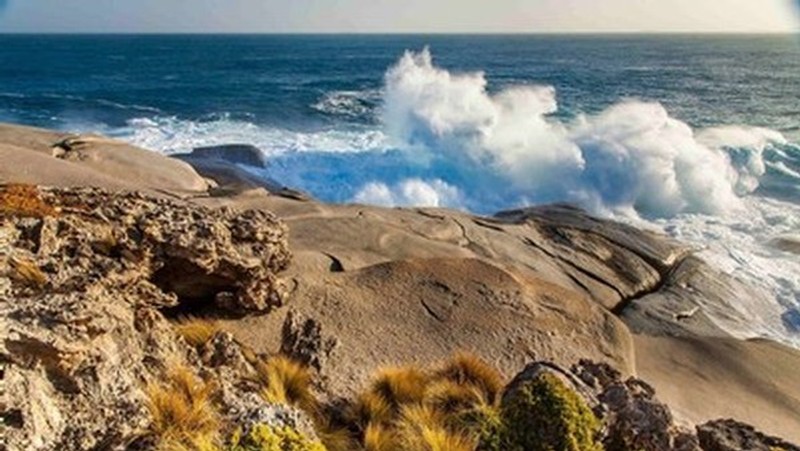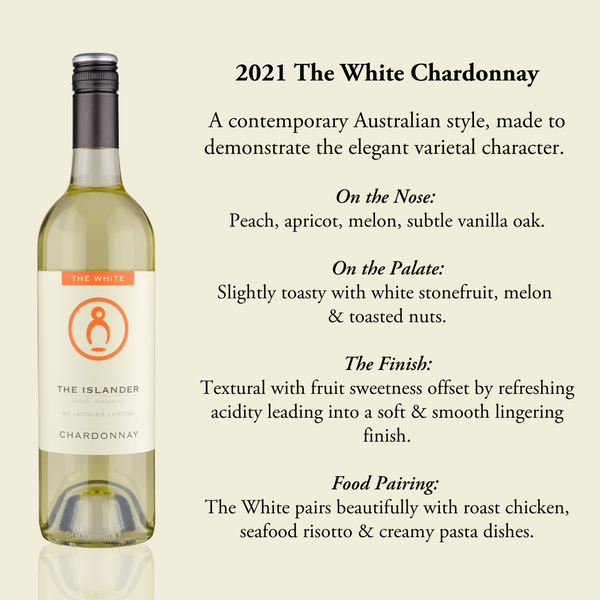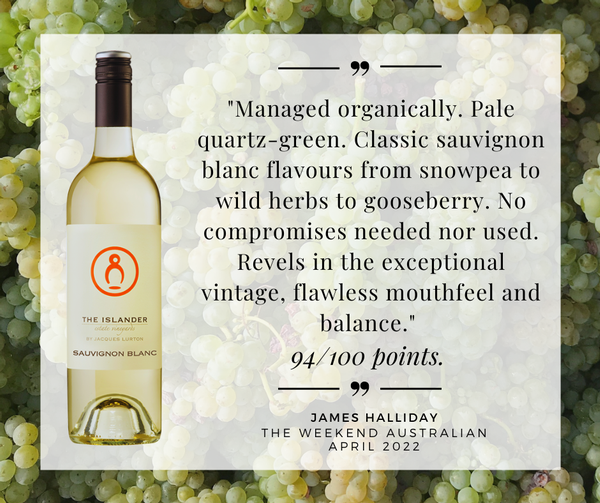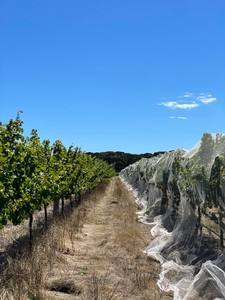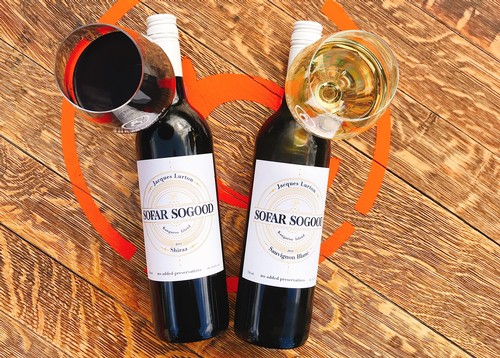News & Reviews
We love sharing our wines and our favourite parts of our beautiful Kangaroo Island. Our blog shares our team's favourite ways to get the most from your visit when you're exploring Kangaroo Island. And of course we like to share the latest news and wine reviews with you too!
Get Intimate with Stunning Malbec
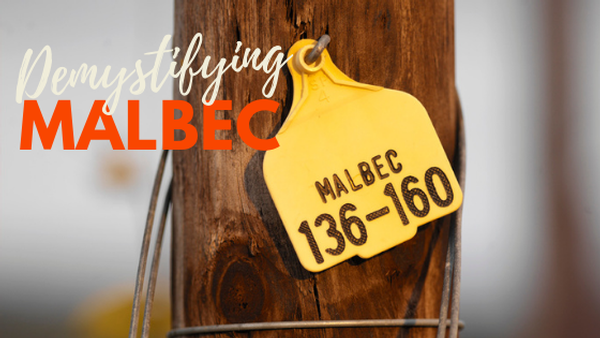
At The Islander Estate Vineyards, we’re celebrating Malbec by raising a glass to this powerful, inky red varietal — and to our journey with Malbec, from France to South America, and ultimately to Kangaroo Island.
Malbec has long been a favourite of our founder, Jacques Lurton, whose connection with this grape spans three continents. So, what makes Malbec so special — and why has it become a signature of our Kangaroo Island wines?
Let’s get to know Malbec.
Malbec's Origins: A Grape with Global Roots
Malbec began its story in Jacques Lurton’s native Bordeaux, where it played a supporting role in classic blends alongside Cabernet Sauvignon and Merlot. But it wasn’t until the variety travelled to Argentina’s Mendoza region that it stepped into the global spotlight.
Brought to South America by French agronomist Michel Aimé Pouget in the 19th century, Malbec thrived in the high-altitude heat of Argentina, becoming the country's most iconic red wine. Today, Argentina produces more than 75% of the world’s Malbec, with France’s Cahors region a distant second.
Australia’s Malbec story started around the 1860s, particularly in South Australia. Initially used for blending, Malbec is now being embraced by a select group of winemakers who see its potential as a single varietal wine.
From France to Kangaroo Island: Jacques Lurton's Malbec Mission
For Jacques Lurton, the journey with Malbec has been personal and passionate.
In France, he worked with Malbec as part of Bordeaux blends.
In South America, he and his brother François established vineyards in Argentina and Chile, seeing first-hand how Malbec dominated the wine scene.
In Australia, he recognised how well the grape adapted to South Australia's Mediterranean climate.
When Jacques founded The Islander Estate Vineyards on Kangaroo Island, he initially planted Malbec as a blending variety. But one taste of the first harvest changed everything. The quality was simply too good to blend away.
Kangaroo Island's Signature Malbec Wines
That first vintage inspired The Majestic Plough — Kangaroo Island’s first and only single-varietal Malbec. The wine set the tone for how beautifully Malbec could express itself on the Island, with structure, depth, and elegance.
As the vines matured, so did the wines. In 2015, Jacques released The Independence Malbec, into The Islander's Flagship Range. Every vintage that has been released has received 96 points from James Halliday’s Wine Companion, placing it amongst the best in the country.
“Hand-picked fruit, destemmed, table-sorted then barrel fermented in seasoned 600L demi-muids; left 5 weeks on skins, matured 24 months in new 600L demis. Deep crimson-purple hue, showing no sign of age. An alluring, expressive bouquet with licorice, polished leather, eastern spices, dried plum and earth all calling out. The palate tucks in behind that array, giving substance and cedary oak tannins on the long, perfectly balanced finish."
James Halliday
We remain the only winery on Kangaroo Island producing Malbec commercially, and we’re proud to showcase the varietal’s potential in this unique maritime climate.
What's unique about Malbec?
Often considered an alternative to 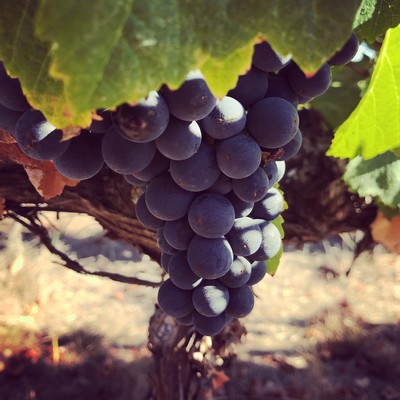 Cabernet Sauvignon or Shiraz, Malbec is a powerhouse wine of its own accord, the most structured and tannic wine we produce on Kangaroo Island.
Cabernet Sauvignon or Shiraz, Malbec is a powerhouse wine of its own accord, the most structured and tannic wine we produce on Kangaroo Island.
Malbec is a thick-skinned, purple grape variety with an inky red hue. On Kangaroo Island, the vines are low-yielding and one of the first red varieties to be harvested.
In the glass, it has an intense deep red colour, magenta-tinged at the rim. On the nose, you’ll find savoury aromas of leather, tobacco, blackberry, dried herbs and spices with plenty of toasty oak.
In the mouth expect big, juicy and plush flavours of dark fruit with a robust structure and moderately firm tannins with natural acidity and a longer finish than you expect from overseas examples.
What Does Malbec Taste Like?
Malbec is often compared to Shiraz or Cabernet Sauvignon, but it’s truly in a class of its own.
Appearance: Inky deep red with a magenta rim
Aromas: Leather, blackberry, tobacco, dried herbs, spices, and toasty oak
Palate: Juicy, plush dark fruit, robust structure, natural acidity, and firm tannins
Finish: Longer than many international examples, thanks to our cool-climate, low-yielding vines
Malbec is the most structured and tannic red wine we produce on Kangaroo Island.
Malbec & Food: A Perfect Match
Few wines pair better with richly flavoured food than Malbec. It’s a natural with:
- Grilled steak, especially with herb or chimichurri sauce
- Roast lamb with garlic and rosemary
- Game meats like duck or pheasant
- Aged or blue cheeses
- Charcuterie and smoked meats
Should You Cellar It?
Absolutely. Our Kangaroo Island Malbec wines age beautifully. With careful cellaring, they’ll reward you for 15 years or more.
Explore Malbec on Kangaroo Island
On this International Malbec Day, we invite you to discover Malbec like never before — crafted on Kangaroo Island by a winemaker with a global legacy. Whether you’re new to Malbec or a long-time fan, our wines offer something truly special.
Discover The Islander Estate’s Vineyards' Malbec
 The Independence Malbec from our Flagship range has just been rated as one of the best in the country. The Australian Wine Companion team rated both the 2015 and 2016 vintage releases 96/100 points. Pop this one away and try not to think about it for a few years—it will pay off.
The Independence Malbec from our Flagship range has just been rated as one of the best in the country. The Australian Wine Companion team rated both the 2015 and 2016 vintage releases 96/100 points. Pop this one away and try not to think about it for a few years—it will pay off.
Shop 2016 The Independence Malbec
 Our Estate range Majestic Plough Malbec is back in stock and in high demand. It is an example of just how good a cool-climate Malbec can be. Drink now or cellar for up to 10 years.
Our Estate range Majestic Plough Malbec is back in stock and in high demand. It is an example of just how good a cool-climate Malbec can be. Drink now or cellar for up to 10 years.
Shop 2021 Majestic Plough Malbec
Kangaroo Island Wine: Australia's Best-Kept Secret (And Why You Need to Know About It)
Welcome to Kangaroo Island, a place where stunning natural beauty meets innovative winemaking.
This pristine island, known for its stunning landscapes and abundant wildlife, is also home to a boutique wine region producing exceptional cool-climate wines.
Learn about the unique terroir, the history of winemaking on Kangaroo Island, and why this region should be on every wine lover's radar.
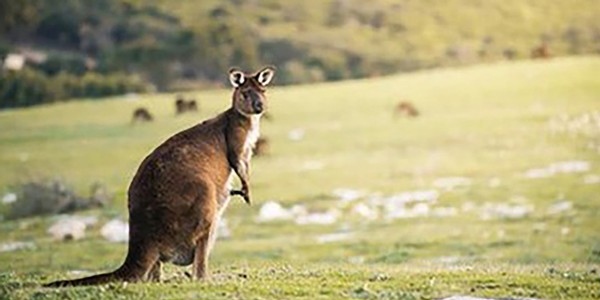
Kangaroo Island: A Natural Sanctuary
Kangaroo Island, Australia’s third-largest island, is globally recognized for its untouched landscapes and native wildlife. Surrounded by the wild Southern Ocean and the Investigator Strait, access is by ferry, small boat, or plane, providing a natural biosecurity barrier ensuring the island remains free of many mainland pests and diseases.
Over 40% of the island is protected through government and private conservation efforts, and its small, environmentally minded community balances low-density tourism, conservation, and agriculture. Kangaroo Island is renowned for wool, lamb, seafood, honey, and, increasingly, its distinctive wines.
Kangaroo Island offers a truly unique wine experience. With over 4,500 square kilometres of pristine beaches, rugged coastlines, native bushland and open farmland, it's a vast and diverse landscape, perfect for crafting distinctive wines.
The island's isolation from mainland vineyard disease, ideal growing climate and undeveloped landscape create a unique environment that directly influences the quality and character of its wines.
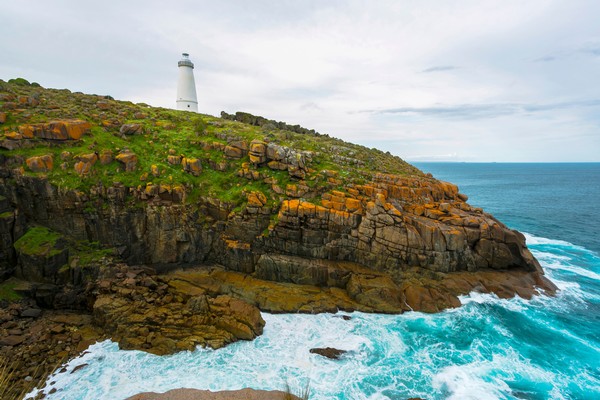
A Journey Through Time: Historical Roots
Kangaroo Island's history is as rich as its wines. From its ancient Aboriginal heritage to the arrival of European explorers like Matthew Flinders and Nicolas Baudin, this island has a fascinating past. The early settlers, including those from the Soldier Settlement Scheme after World War II, laid the groundwork for the agriculture that thrives here today.
The island's isolation has helped preserve its unique character. This rich history is woven into the fabric of Kangaroo Island's wine culture, adding depth and character to every bottle.
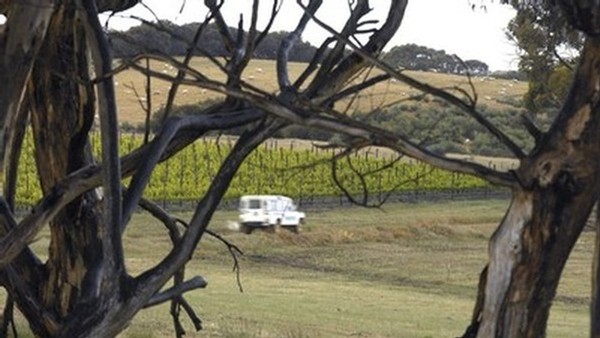
Kangaroo Island Wine Region: A Unique Terroir
Registered as a Geographic Indication in 2000, Kangaroo Island is one of the five regions within the Fleurieu Zone. It stands as Australia’s only Geographically Indicated small island wine region.
What makes Kangaroo Island wine so unique? It's all about the terroir. The cool maritime climate, influenced by the Southern Ocean, creates ideal growing conditions for premium grapes. This results in wines with exceptional balance, elegance, and vibrant flavours.
Unlike warmer regions, Kangaroo Island's long, slow ripening season allows grapes to develop complex flavours while maintaining refreshing acidity. This means you'll find wines with purity and finesse, reflecting the island's pristine environment.
The diverse soils, ranging from acid duplex to alkaline sands, contribute to the variety of wine styles produced here. The region is ten times the size of McLaren Vale, with just seven wine labels growing vineyards across diverse sub-climate zones and soils. Vineyards are surrounded by vast tracts of native vegetation and open farmland, each with a unique terroir.
Key facts include:
Location: 15 km off South Australia's coast;
Vineyard size: Est. 140 hectares; Latitude: 35° 83’S;
Longitude: 137° 38’; Altitude: 0-316 meters;
Growing season rainfall: 199mm.
Climate: Cool-temperate, Mediterranean, maritime, with south-easterly winds from the Southern Ocean.
Average summer temperature: 25°C, 3-4°C cooler than mainland South Australia in summer, warmer in winter, low diurnal range.
Soils: Acid duplex to alkaline sands, loams, clays overlaying limestone, similar to Padthaway soils.
Harvest: Later than mainland, March to late April.
Grape varieties: Shiraz, Cabernet Sauvignon, Sauvignon Blanc, Cabernet Franc, Sémillon, Tempranillo, Viognier, Malbec, Grenache.
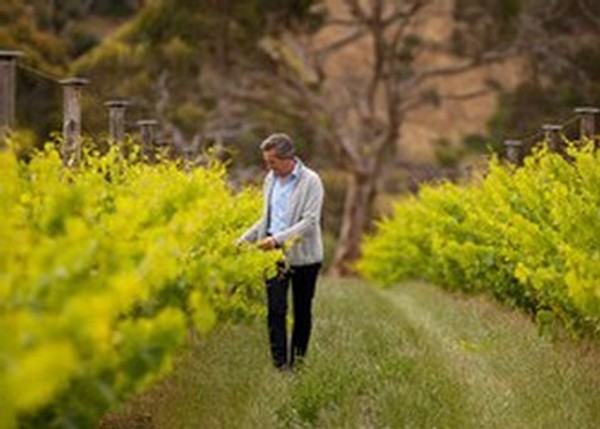
What Makes Kangaroo Island Wines Unique?
Kangaroo Island’s wines are a product of their remote, untouched environment, cool climate, and maritime influence. The cooler climate and slow ripening produce medium-weight wines with elegant structure, lower alcohol, and higher natural acidity. The island's isolation minimizes pests and diseases, allows for sustainable growing techniques using organic methods. The diverse terroir, with varied microclimates and soils, allows for a range of wine styles.
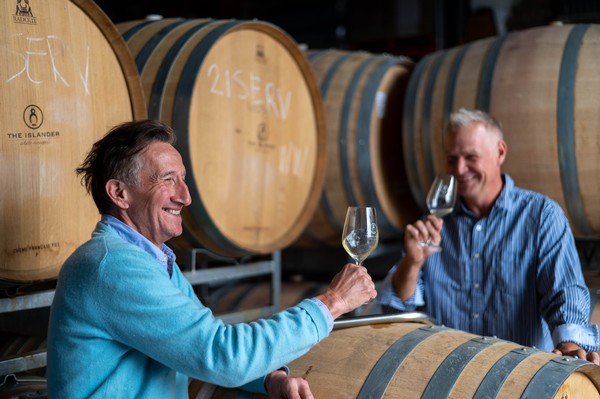
The Islander Estate Vineyards: A Benchmark for Quality
The Islander Estate Vineyards is a leading producer founded by Bordeaux-born winemaker Jacques Lurton. Inspired by the island's potential, reminiscent of Languedoc-Roussillon, Lurton established an 11-hectare vineyard with 5,000 vines per hectare, planting Semillon, Cabernet Franc, Malbec, Grenache, Viognier, and Shiraz. The estate employs organic and minimal intervention methods, with winemaking equipment imported from France. The wines blend French expertise with Kangaroo Island’s terroir, emphasizing elegance, balance, and terroir expression.
Jacques Lurton's vision to showcase Kangaroo Island's potential has resulted in wines that blend classic French winemaking techniques with the island's unique terroir. The focus on minimal intervention and organic practices ensures that the wines truly reflect their origin.
Experience the elegance and complexity of The Islander Estate Vineyards' wines, and discover why Kangaroo Island is a must-visit destination for wine enthusiasts.
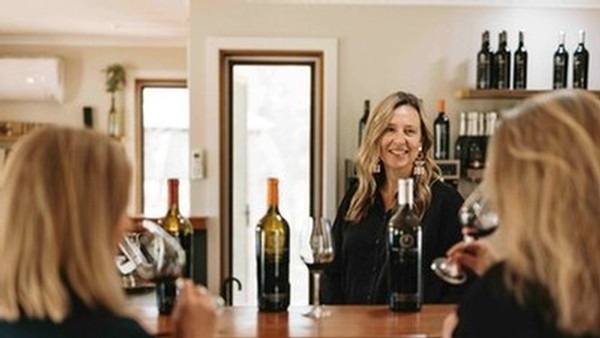
Why Kangaroo Island Should Be on Your Wine Radar
Kangaroo Island's wine scene, still under the radar, offers boutique wineries, intimate cellar-door experiences, and exclusive small-batch wines. Its unique environment and winemaking approaches result in distinctive, high-quality wines.
Ready to explore the hidden gem of Kangaroo Island wine? Plan your visit and experience the beauty and flavours of this unique region. Whether you're a seasoned wine connoisseur or a curious traveller, Kangaroo Island offers an unforgettable wine adventure.
Visit our Tasting Room for an intimate hosted wine experience, or explore our online store to bring a taste of Kangaroo Island home.
Discover more about The lslander Estate Vineyards
Plan your Kangaroo Island Holiday
Book a Premium Wine Tasting Experience
A Year in Our Kangaroo Island Vineyard - Spring

A Year in Our Vineyard: Spring
Our annual vintage may last just a few weeks, but it takes an entire year of hard work to ensure we are harvesting the best possible grapes.
Come with us for a guide to a year in our vineyard – one season at a time.
The growing season on Kangaroo Island
Thanks to the influence of the Southern Ocean & its prevailing south-easterly breezes, Kangaroo Island has a maritime environment significantly different to the rest of Australia, even to nearby McLaren Vale. These ocean breezes mean an even climate without extremes. They cool the vineyards in summer and keep it a few degrees warmer and wetter during winter, offering some protection from disease and frosts caused by extreme cold.
The annual cycle of a grapevine
A vineyard's reliable annual growth rhythm is a reminder that nature will continue, no matter what variation or disasters might occur in a single year.
Kangaroo Island’s native vegetation is perennially green. Its grasslands & crops thrive in winter, becoming a dry Mediterranean landscape in summer. Conversely, our vineyard works on an opposite calendar, becoming dormant in winter & bursting to life in Spring as much of the Island begins to dry and turn brown and is at its most productive at the end of a long dry summer.
Spring in our Vineyard
Budburst (late Aug/early Sept) 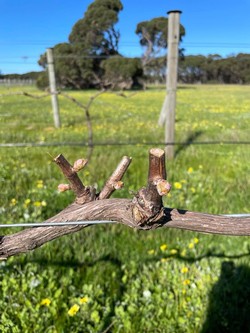
Budburst is the first sign of life in the dormant vines. The roots and wood of the vine release a surge of energy, the sap rises and the buds begin to break through.
The woolly buds are extremely delicate during this time, so viticulturalist's pray for Spring frost to stay away. Luckily, our vineyard favours elevation & ocean breezes which largely protect cold air from settling & becoming frost.
Three factors impact the arrival of budburst. Firstly, the air temperature dictates the timing and pace of bud formation. Secondly, the variety, with each variety classified as early, mid, or late budding. Early budding varieties like Chardonnay tend to be more frost tolerant and often early ripening. Finally, the temperature of the soil plays a role in bud development.
Early Shoot & Leaf Growth (October/Nov)
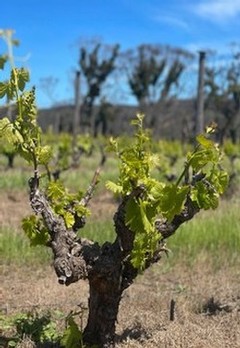 Once budburst is underway, growth starts to speed up, with shoots growing and leaves forming almost before our eyes.
Once budburst is underway, growth starts to speed up, with shoots growing and leaves forming almost before our eyes.
Shoots are initially fuelled by the carbohydrate reserves fed up from the roots, but photosynthesis kicks into gear as leaves start to unfurl and mature.
At this early stage of the growing season, it's important to ensure the vines have a good water supply and nutrients, employing organic principles.
Our vineyard team gets busy thinning shoots to ensure we have optimal selections and training the shoots where needed. Shoot thinning ensures the vine concentrates its energy into the shoots selected for fruit production in line with our high-density, low-yield growing principles.
Flowering & Fruit Set (Nov/Dec)
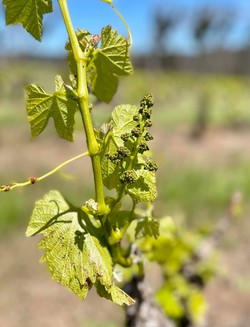 Next, flower buds will begin to form on the new growth in tiny clusters, also known as inflorescence. Also known as ‘perfect flowers’, the grapevine flowers self-pollinate. Bees are not required!
Next, flower buds will begin to form on the new growth in tiny clusters, also known as inflorescence. Also known as ‘perfect flowers’, the grapevine flowers self-pollinate. Bees are not required!
This is the time of the growing season when we pray for warm sunny days, moderate frost-free nights, gentle breezes and little or no rain.
These are the conditions for maximum self-pollination and pave the way for fruit set, the formation of tiny bunches of fledgeling grapes.
Once fruit set is complete, grapes begin to form, and this provides us with the first indication of the vintage to come.
Fruit-set provides us with the vintage potential, but challenges come as Summer approaches!
We look forward to continuing to share the journey to vintage as our growing season progresses.
Follow our social media channels to share our story as we head towards Vintage 2024.
Facebook Instagram or subscribe to receive our news & wine offers
Vintage 2022 report. Getting back to business.
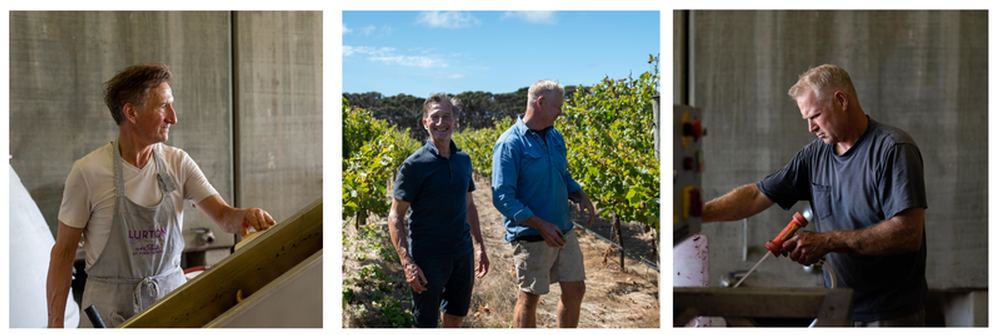
Vintage 2022 has been an enormous milestone in our recovery from the 2019/2020 bushfires, which devastated our estate in the stunning Kohinoor Hills on Kangaroo Island.
We were excited to be back producing again at our home winery & buoyed by the recovery of our vineyard.
With international covid restrictions easing, Jacques Lurton was back on deck on Kangaroo Island to kick off vintage.
Having our dream team back together felt so good!
Growing Season
Kangaroo Island experienced a wet winter in 2021, followed by a challenging flowering during November. These same conditions were experienced across much of South Australia, resulting in widespread lower fruit-set.
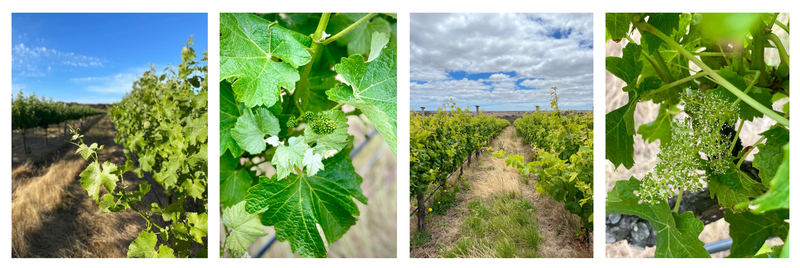
Ripening
As always in viticulture, every challenge has a silver lining. As a result of the below-average flowering, our vines concentrated their energy on a smaller amount of fruit. Summer 2021/2022 has been mild, creating a long slow ripening period resulting in red varieties with an outstanding balance of fruit & acidity.
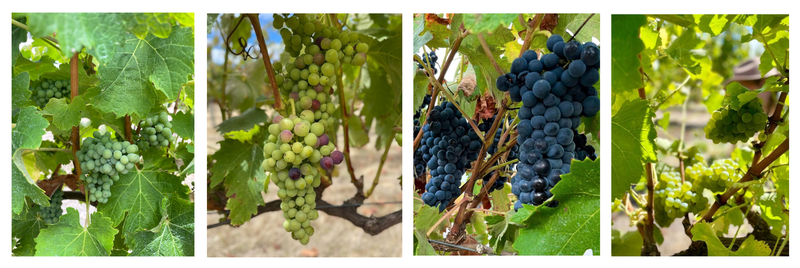
Harvest
Harvest kicked off on the 10th of March with a small crew hand-picking an excellent crop of Sauvignon Blanc at the Haines vineyard. Over the next 5 weeks, we processed around 70 tonnes of grapes concluding with a hand-pick of our signature variety Cabernet Franc on the 14th of April. We celebrated our first harvest from our Kohinoor Hills vineyard with two volunteer picking days where we were joined by friends, community members & loyal customers.
It was exciting & energising to be harvesting from our estate just two years post bushfire. Our yield was small compared to pre-bushfire levels, but we are confident our recovery rate will improve significantly over the next two years.
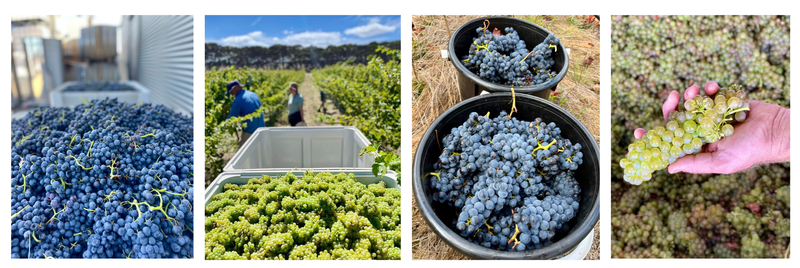
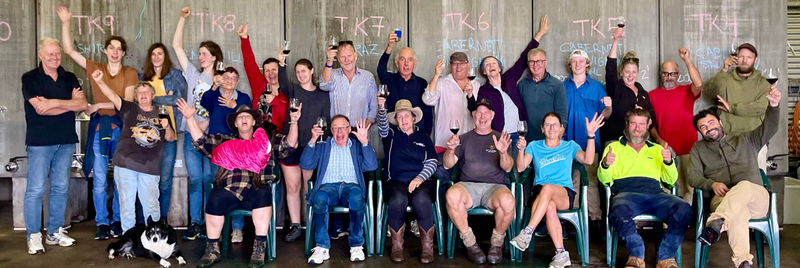
As always in a small wine business, vintage means all hands on deck. The entire Norris family jumped in for long days & even longer nights. Yale's son Wynn became the #1 vintage hand. A next-generation winemaker in the making! And it was wonderful to have Jacques' wife Natalie Lurton join our picking team.
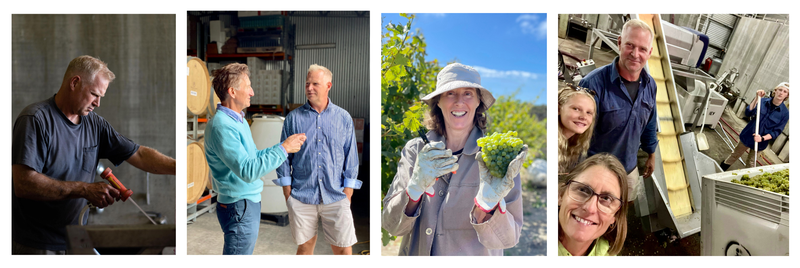
Winemaking
It is energising to have our winery close to full capacity again with delicious wines in concrete, steel & oak. While it is still early days, we are excited about our 2022 whites, including Sauvignon Blanc, Semillon, Viognier & Rose. In our red varietals, Cabernet Sauvignon is the early standout & we cannot wait to see how our Cabernet Franc develops in its first post-fire yield.

Upcoming Releases
We are preparing to bottle & release several new wines in the coming months. We can't wait to share them with you.
Don't forget our Discoverer's Wine Club members receive advance access to our new, most popular & limited release wines.
Click here to Explore the Benefits.
Close up on Chardonnay
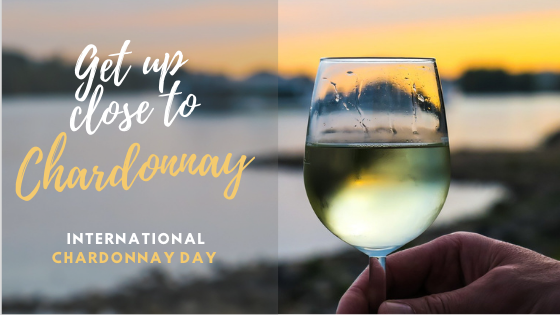
May 25th is International Chardonnay Day.
It’s the most widely planted white grape variety in the world. And its time has come around again. So, let’s get reacquainted with Chardonnay.
Chardonnay’s Origins
Chardonnay’s birthplace is the Burgundy region of France, in a small village of the same name. Chardon is the French name for a thistle, chardonnay’s name originates from “place of thistles”. Believed to be from the Noirien family of grapes, chardonnay is descended from Pinot Noir and the ancient variety Gouais Blanc.
In Burgundy, where chardonnay is known simply as white Burgundy, it is the most prized white grape variety, seen as truly capturing the region’s incredible terroir. Although it originated in France, chardonnay is now grown in almost every wine region on Earth, mostly because of its ability to adapt to different environments and grow almost anywhere.
Chardonnay down under
Chardonnay was first bought to Australia by James Busby (widely known as the ‘father of Australian wine’) who planted the first cuttings in Australia in the 1830s. It didn’t become a core Australian variety for almost a hundred years, but by the 1980s chardonnay became one of the most recognised Australian white wine varieties; flourishing in our climate and mainly produced in robust, rich, ripe, and buttery styles.
Over the next several decade Australian wine consumers' palates changed as they moved towards the zesty, higher acidity alternatives like Marlborough sauvignon blanc. Australian winemakers began to adapt, taking advantage of Chardonnay's ability to take on many different characters guided by the winemaker’s technique.
Today chardonnay accounts for more than half of Australia’s white wine production, having a renaissance in a lighter style closer to the Chablis style of France. This contemporary style has inspired The Islander Estate Vineyard’s The White Chardonnay.
Chablis Style Chardonnay
Located in the Burgundy region of France (also famous for Pinot Noir), the Chablis appellation lies in the north, alongside the River Serein with the best vineyards planted along the south-facing slopes. Chardonnay here is all about the terroir.
Forget all your preconceptions of oaky, buttery Chardonnay. The Chablis style is entirely different, some say this style is the purest form of Chardonnay, fermented in steel, usually with little or no oak so the Chardonnay grapes' taste and aroma can shine. The Chablis wine style is dry, lean, and light-bodied with higher acidity and green apple, citrus, and mineral notes.
At our Tasting Room, two of our most common guest comments are "I don't usually really like chardonnay but this is really nice" or "Sauvignon Blanc is my go-to white wine, but this is really delicious".
Are you a champagne lover? Then you'll like Chardonnay.
Chardonnay is the main component of most champagne (blended with its mother variety, Pinot Noir as it is in our Petiyante sparkling). And if you’re a fan of Blanc de Blancs you’re drinking champagne made entirely of chardonnay.
Chardonnay’s food companions
Our The White Chardonnay is designed for everyday drinking, we think it makes a phenomenal sunset glass of wine with friends or with a simple soft cheese, but there are loads of cool weather matches with chardonnay. Simply, Chardonnay prefers subtle spices and creamy or buttery flavours with seafood, chicken, or even pork. Try it with a few of these classic Autumn dishes:
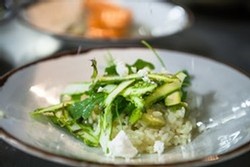 |
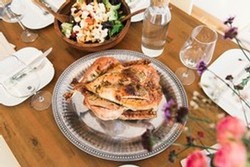 |
|
Vegetable Risotto
|
Classic Roast Chicken
|
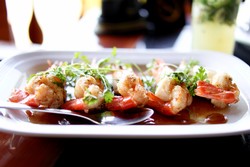 |
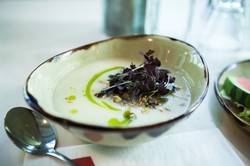 |
| Garlic Prawns | Vegetable Soups |
Drink now or wait?
Contemporary unoaked styles just like our The White Chardonnay is made in an everyday drink now style but can happily hang out in your wine rack for two years. More heavily oaked examples offer more cellaring potential.
Get intimate with The Islander Estate Vineyards The White Chardonnay
Priced for everyday drinking, now is a great time to get your hands on The White. Click on the image below to add some to your shopping cart now.
Take a fresh look at Sauvignon Blanc
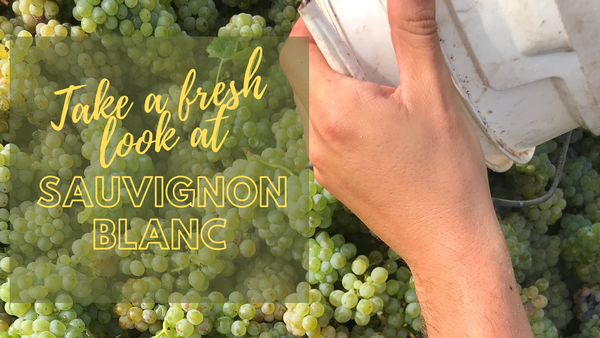
It's the white wine in almost every Australian wine fridge during the warmer months. Sauvignon Blanc may be popular but producing high-quality wine requires a skilled winemaker & impeccable timing.
With its huge rise in popularity in recent years, most Australian white wine drinkers have included Sauvignon Blanc in their wine repertoire. There is a lot to learn about this variety which can produce very varied characteristics with a careful winemaking hand.
Here are some facts about one of our favourite varieties you may not know:
- It's no new kid on the wine block. Sauvignon Blanc originated in France in the 1500's the Loire Valley & Jacque Lurton's native Bordeaux, where it features in famous French wines like Sancerre and Pouilly-Fumé.
- Sauvignon Blanc has a wild side. Its name comes from the French words' sauvage' meaning wild and 'blanc' meaning white.
- Sauvignon Blanc in Bordeaux is most known as a major player in the sweet wine Sauternes.
- Bordeaux's most famous white blend, Bordeaux Blanc, pairs Semillon & Sauvignon Blanc in the world's original Sem-Sauv-Blanc blends.
- Believe it or not, Sauvignon Blanc is the mother of the robust tannic red wine variety Cabernet Sauvignon (Cabernet Franc is the father).
- Sauvignon Blanc grows best in cool or maritime climates (both Bordeaux & Kangaroo Island feature maritime environments) where long, even growing conditions balance its crisp acidity with fresh fruit character.
- Sauvignon Blanc was one of the first varieties to be described in terms of one of its dominant flavour compounds, methoxypyrazines. This compound is responsible for the Sauvignon Blanc's herbaceous nature, including characteristics like asparagus, cut grass, capsicum, dried herbs and gooseberries. Next time you taste wine with friends, drop this term!
- Not all Sauvignon Blancs are the same. It can vary wildly based on where it's grown & winemaking techniques, so try a wide range of regions & styles.
- It has an alias. Fumé Blanc –coined in California in the 1960s and popularized by Robert Mondavi. Fumé Blanc is Sauvignon Blanc. Sometimes aged in oak, giving it smoky notes (fumé means smoke), definitely one to try if you are looking for a more textural & complex Sauvignon Blanc.
Looking for foods that pair beautifully with Sauvignon Blanc? Easy, if a squeeze of lemon would enhance the dish, you'll be onto a winner serving them together.
We have minimal quantities of our 2021 Sauvignon Blanc left online & at our Tasting Room, order yours now
A year in our Kangaroo Island vineyard - Summer
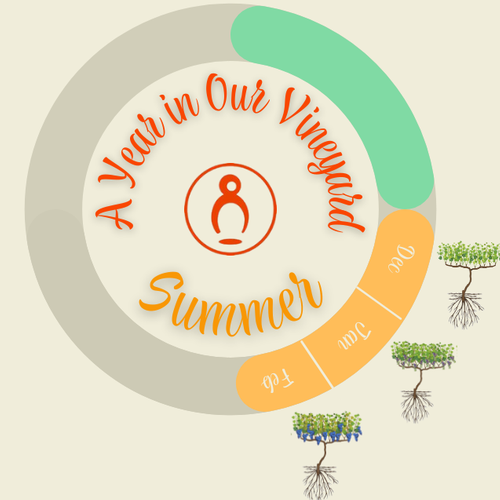
Our annual vintage may last just a few weeks, but it takes an entire year of hard work to ensure we are harvesting the best possible grapes.
Come with us for a guide to a year in our vineyard – one season at a time.
The Summer wine growing season on Kangaroo Island
Spring may be when the vineyard bursts from dormancy back to life, but Summer is when things begin to get exciting, giving us a glimpse towards the potential of the next vintage.
Summer is the season that can make or break vintage. The climate on Kangaroo Island in early summer can still be variable. Optimum conditions for a good vintage are warm, dry days with mild winds. Excessive rain, wine or humidity can all spell disaster.
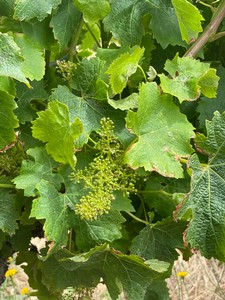 Fruit Set (Dec)
Fruit Set (Dec)
As flowering begins to end, the fertilised flowers start to develop a seed and grape berry to protect the seed. This stage is critical as it determines the potential crop yield.
Now is the time we begin to get a good idea of bunch development and quality on the vine with an insight into how vintage may shape up if the weather remains at optimum conditions.
At this stage of the growing season when we pray for warm sunny days, moderate frost-free nights, gentle breezes and little or no rain.
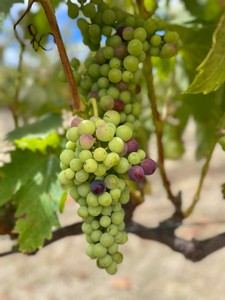 Véraison (January)
Véraison (January)
During January, the tiny bunches of grapes go through a rapid period of growth. Once they reach around half their final size, they enter the stage of véraison, usually around 40 – 50 days after fruit set. However, the grapes remain hard, have very little sugar & are high in organic acids.
Throughout véraison the berries begin to ripen, turning from green and begin to turn purple, red and golden. This tipping point is when the vine begins to turn its energy away from vine growth concentrating on developing sweetness in the grapes.If necessary, leaf thinning is undertaken to allow the grapes more access to light & increase airflow to minimise disease risk.
Berry Ripening (February)
After véraison the grapes swell & fill with water. During this ripening period, sugar levels rise & acid levels drop. Colour pigments, flavour compounds & tannins develop. Watering stops to induce mild water stress, inhibit shoot growth & encourage concentrated character in the ripening grapes.
A close eye is kept on the vineyard & when flocks of marauding birds arrive, nets are installed across the vineyard to protect the crop. Once nets are on, vintage is only a matter of weeks away.
Many regions begin vintage in February, however in the cooler conditions on Kangaroo Island, wine vintage traditionally begins a few weeks after other South Australian regions, often in March.
We look forward to continuing to share the journey towards Vintage 2022
Follow our social media channels:
Facebook
Instagram
Subscribe to receive our news & wine offers
Vintage 2021: Beyond the Bushfires
As we launch our first Vintage 2021 wines, we're taking the opportunity to update our many loyal customers on how we've adapted our winemaking processes to ensure we can continue to supply you with the wines you love.
We also share an update on the outlook for The Islander Estate Vineyards as we continue on our road to recovery from the 2020 bushfires.
Order 2021 Wine Releases Now
What's (So Far) So Good about preservative free wines?
Every day in our Tasting Room we chat to guests interested in our preservative free wines. These days we’re all a little more aware of ensuring we know what’s in our food and wine, so join us for a closer look at preservative free wine.
Why make a preservative free range?
Our owner Jacques Lurton introduced the SoFar SoGood range around 4 years ago. After he found himself developing a reaction to the sulphites we find in many everyday foods and drinks. Chatting to friends and customers, he identified a growing trend in seeking out products with less preservatives and decided that his vineyard on Kangaroo Island was the ideal place to trial a no-added preservative wine range.
What is preservative free wine?
A small amount sulphur dioxide is released naturally by the grapes during fermentation (nature’s own preservative) so all wine contains trace amounts of naturally produced preservative.
Wines labelled preservative free mean the winemaker has not added any preservatives during the winemaking process.
What preservatives are added to wine?
Wines generally contained sulphur dioxide (SO2), or you may see “sulphites added” on the label, this can mean S02 or HS03 (bisulphites) and H2SO3 (sulphurous acid). In Australia strict restrictions on the amount of sulphites are in place and where they exist in the wine labelling laws require it to be declared. This is not the case with wines from many countries outside Australia.
You will find these same preservatives in higher concentrations in many supermarket products including dried fruit, jams, candy, processed meats and many packaged foods. So if you react to these foods it may be an indication of a sulphite sensitivity.
Why are they used?
Sulphites have been used in wine since the early 1900s to help preserve the wine and slow down the deterioration process. It is used to get the wine into the bottle and to the drinker in the best condition.
Generally low or preservative free wines require pristine grapes in the best possible condition, handled carefully in the winery. Less faults with the grapes mean less (or no) sulphites are required.
Do Sulphites give you a headache?
Lots of guests our feel they can drink more of our preservative free wines without getting a hangover. Science indicates this is not the case but people with asthma are thought to be more likely to have a sulphite sensitivity and if you feel you react to any of other foods listed above it may be worthwhile giving a preservative free wine a try.
What’s different about how we make preservative free wine?
The goal in producing preservative free wines is to use the utmost care and keep intervention to a minimum. For our SoFar SoGood range, nature does much of the winemaking with the winemaker playing supervisor.
The first step is to start with pristine grapes free of disease or bird damage. Then the grapes are handled carefully in the winery, kept cool and away from air as much as possible.
At The Islander Estate Vineyard, we pick by hand, destem and send the wine to tanks for ferment (by wild yeast for our Shiraz). We use temperature control and soft extraction during ferment phase, pressing the skins off early.
As soon as fermentation is complete, the wine is clarified, filtered and into the bottle within around 8 weeks of picking (even earlier for our preservative free Sauvignon Blanc).
Our SoFar SoGood range is designed to be enjoyed young as are most preservative free wines.
How are preservative free wines different to drink?
Because of the minimal intervention approach, we find our preservative free wines tend to tell a pure story of the fruit and vineyard. They are easy drinking, vibrant and packed with fruit flavours.
As well as people with sulphite allergies, we find the SoFar SoGood range appeals to wine lovers who enjoy fruit forward and well balanced but less tannic or structured wines (think Pinot Noir or Merlot lovers).
Why not try our 2019 SoFar SoGood preservative free range?
A Year In The Vineyard
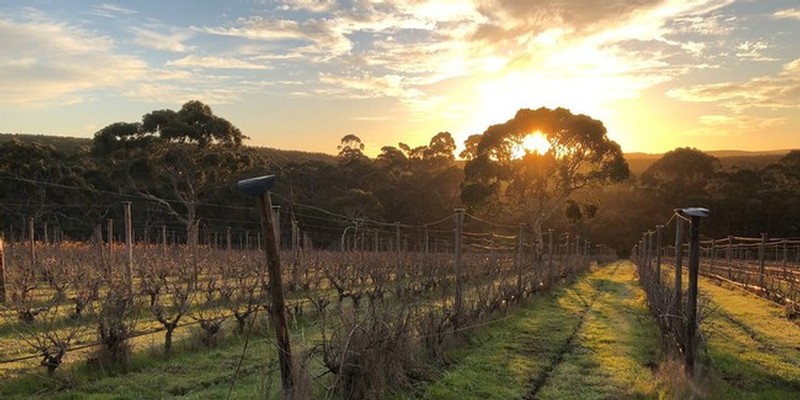
September/October: Inflorescence – Also known as 'Budburst' signals the official start of the new growing season.
November: Floraison – the buds begin to flower before producing tiny bunches.
Late November/December: Fruit set – now we begin to get a good idea of bunch development and quality on the vine with an insight into how vintage may shape up if the god’s are kind.
Late January: ‘Veraison' – the beginning of ripening where berries turn from green and begin to turn purple, red and golden. A tipping point when the vine begins to focus its energy on development sweetness in the grapes.
March to May: Harvest! Can begin from late February but most often in March. We will pick for six to eight weeks, checking the vineyard daily and hand-picking only what is perfectly ready. From early May, the focus of the winemaking crew turns away from the vineyard and into the winery.
June - September: Even as the grapes are harvested, the green foliage begins the yellow and leaves drop. As the weather turns cold, the vine withdraws its energy to the roots and returns to their dormant state. The vineyard slows but doesn’t stop as our pruning crew methodically work their way through the vineyard hand-pruning.
